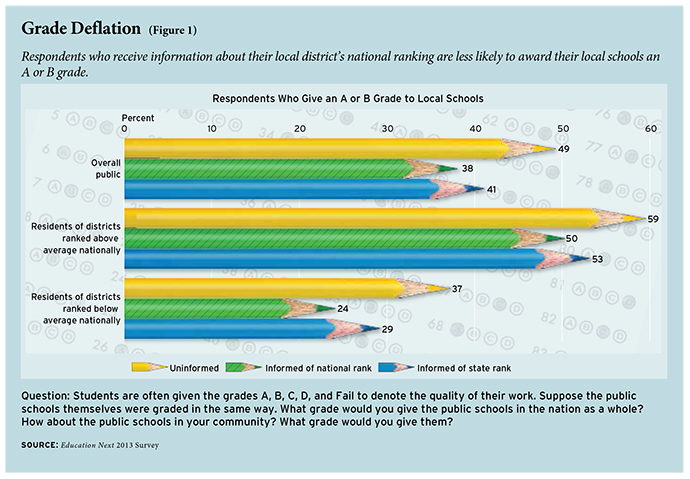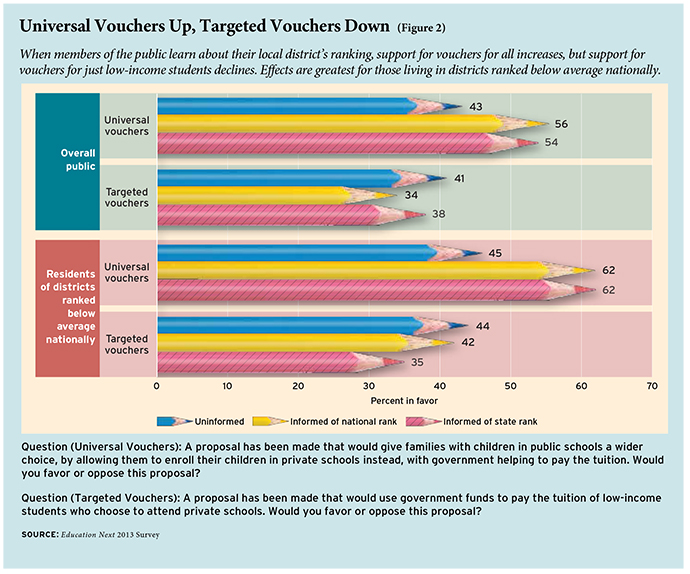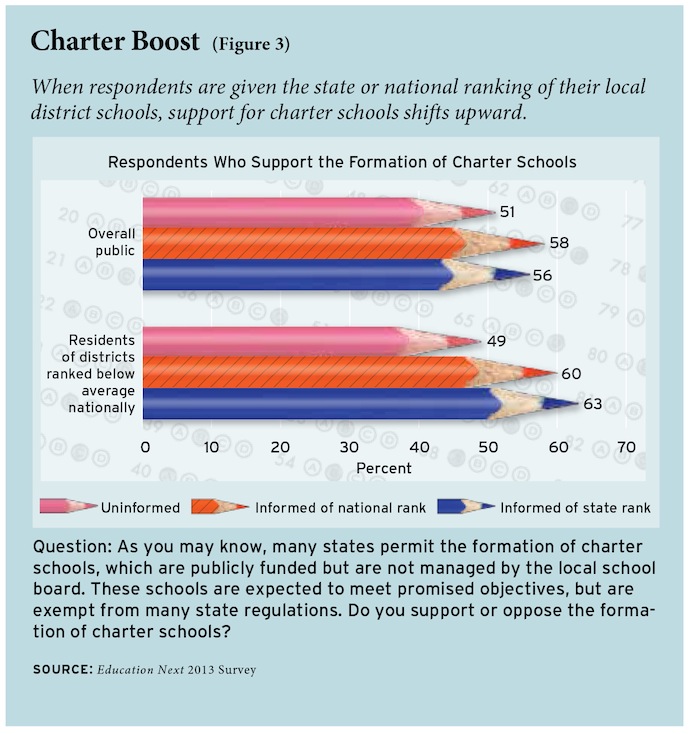The Common Core State Standards initiative (CCSS) seeks to “provide a consistent, clear understanding of what students are expected to learn” at various grade levels. For some education observers, CCSS will finally clarify for students, parents, and educators what students need to know and be able to do if they are to be prepared for college or a career. For others, CCSS interferes with local control of schools, limits teacher creativity, and diverts classroom time and energy away from instruction to test preparation. But as pundits and practitioners thrust and parry over these issues, they may be overlooking the potential impact of CCSS on public perceptions of school quality and public support for school reforms.
If CCSS is fully implemented as proposed by its most ardent adherents, including the National Governors Association and the Council of Chief State School Officers, it can be expected to alter the information Americans have about student performance at their local schools. Currently, the public has no national metric to guide its assessments of local school performance. At best, one can find out the percentage of students deemed proficient by state standards, which are known to vary widely in their definitions of proficiency. Were a common metric used to assess student performance, as CCSS promises, each school district could be ranked nationally as well as within its state.
Recently, the state of New York embraced CCSS, and in the process adopted a much higher definition of proficiency. When the new test results were released, the percentage of students identified as proficient in math dropped from 65 to 31, and in English from 55 to 31. The gap between white and minority students remained wide, as only 16 percent of black students and 18 percent of Hispanic students were deemed proficient in English. Asked for his opinion, Secretary of Education Arne Duncan replied that “the only way you improve is to tell the truth. And sometimes that’s a brutal truth.” The results ignited debate in New York City’s mayoral campaign, where candidates searched for ways to differentiate themselves from the Bloomberg administration’s education agenda.
Are the developments in New York unique to that state? Or is there reason to think that rigorous national standards, with accompanying measures of student performance, have the power to generate the political attention needed to refocus public opinion? To shed light on this topic, we report here experimental results from the 2013 Education Next poll, which consists of a representative sample of the American public, and which was conducted under the auspices of the Harvard Program on Education Policy and Governance.
Our findings reveal that when respondents learn how their local schools rank in comparison to the performance of schools elsewhere in the state or in the nation as a whole, they become more supportive of school choice proposals, such as making school vouchers available to all families, expanding charter schools, and giving parents the power to trigger changes in their local school. Upon learning the rankings of their local public schools, Americans also give lower evaluations to these institutions, just as they express less confidence in and support for teachers. A majority remain supportive of federal accoutnability provisions, however, whether or not they are informed of their district’s rankings.
Survey Methodology
Experiments generating these results were conducted as part of a 2013 Internet survey of several thousand members of the U.S. public, including oversamples of teachers, parents, African Americans, and Hispanic respondents. To carry out the experiments, we divided respondents randomly into groups of roughly 1,000. One representative group was left uninformed as to the performance of students at its local schools. (We realize, of course, that some within this group may have acquired knowledge about student performance independently from sources other than our survey questionnaire. The group is uninformed, therefore, only in the technical sense that its members were not given specific items of information supplied to the other groups.)
Other groups were given specific information about the performance of students in their local public schools. The information given to two of the groups is especially relevant for gauging the possible effects of the Common Core on public opinion. Members of these groups were told about either the state ranking of the average student in the respondent’s district on standardized tests of achievement or the national ranking of the performance of the average student in the district. The difference between the opinions of the uninformed group and those of each of these two groups provides clear estimates of the impacts of new student-performance information on public assessments of local schools and public views about school reform policies.
Once introduced, information on state and national rankings was available to the respondent throughout the survey, allowing respondents to make use of the data while contemplating their evaluations of schools and considering their views on policy matters. By making the information available, all policy questions are subjected to the treatment information. (See sidebar below for details on survey design; for full survey results, go to www.educationnext.org.)
We expect new information about local district rankings across the state and nation to alter public opinion in four domains. If the new information surprises respondents by indicating the district is doing less well than previously thought, the public, upon learning the truth of the matter, is likely to 1) lower its evaluation of local schools; 2) become more supportive of educational alternatives for families; 3) alter thinking about current policies affecting teacher compensation and retention; and 4) reassess its thinking about school and student accountability policies. In this regard, we expect the largest changes to occur in those districts that rank below the median district nationwide. Meanwhile, should local schools perform higher than expected, as they may for at least some respondents living in districts in the upper half of the national rankings, then the opposite pattern of results may emerge. In the remainder of this report, we show the extent to which our findings are consistent with such expectations.
Accountability Standards
Critics of CCSS in New York are calling for a moratorium on the use of new standards and testing. As Randi Weingarten, president of the American Federation of Teachers, recently penned, “In New York, officials rushed to impose tests and consequences way before students were ready…. That’s why last spring I called for a moratorium—not on the standards or even on the testing, but on the stakes that could unfairly hurt students, teachers and schools during this transition to the Common Core. Tens of thousands have supported this moratorium.” But we find little evidence of a public backlash against Common Core and test-based accountability, at least on the basis of new information about local school district rankings. In the absence of any information about local student performance, 64 percent of Americans support CCSS and only 13 percent oppose them. Support among those residing in below-average districts does drop by 7 percentage points when statewide ranking information is provided, but even among this group a clear majority remains supportive. Respondents in more highly ranked districts remain unfazed.
We also asked respondents what they think about requiring 3rd-grade students to pass a state reading test before moving on to the 4th grade. Nearly four in five uninformed Americans support this requirement, and information about local district ranking does not reduce support for this sort of high-stakes testing in either above-average or below-average districts. Knowledge of district rankings, however, has a slight effect on support for high school graduation exams. As with high-stakes tests for 3rd graders, Americans come out strongly in favor of graduation requirements. In both high- and low-performing districts, however, support for this requirement drops 5 percentage points when respondents are informed of how students in their community compare with the rest of the nation. Even then, however, roughly 70 percent of respondents express support for graduation requirements.
In short, there seems to be some evidence that better information about a district’s ranking weakens support for accountability, but the downward shift is modest relative to the overall support for these policies, and it is generally limited to residents of below-average districts.
Evaluations of Schools
When asked to evaluate their local public schools, uninformed Americans give much more positive assessments than they offer when asked about the nation’s schools. Overall, 49 percent say that their local public schools deserve an “A” or a “B” on the scale traditionally used to evaluate students, but only 20 percent say so when respondents are asked about schools nationwide. The distance between these two judgments narrows, however, when Americans are told the ranking of their local school districts either within their state or in the nation as a whole. Those giving local schools one of the two highest grades stands at 49 percent among the uninformed but just 41 percent among those told their own district’s ranking relative to other districts across the state (see Figure 1). When given the district’s national ranking, the portion of respondents giving these high evaluations drops to 38 percent. Interestingly, the size of the decline is roughly the same whether the respondent lives in a school district ranking above or below the state or national average.
While information about local district rankings shifts evaluations of local schools downward, it has little impact on assessments of the nation’s schools. This should not surprise, given that the provided information concerned the ranking of the respondent’s own local school district rather than the nation’s schools as a whole. Moreover, the public already has a pretty good understanding of the quality of the nation’s schools. Before introducing the experiment, we asked all respondents to give their best estimate of the U.S. high-school graduation rate within four years of students entering 9th grade. The public estimate is 66 percent, a bit lower than the 72 percent estimated by the U.S. Department of Education. We also asked the public to estimate international ranking for the math performance of U.S. 15-year-olds. On this matter, the public’s knowledge is surprisingly accurate. On average, the public thinks U.S. students rank about 19th internationally, just a bit better than the 25th place that a test administered by the Organization for Economic Cooperation and Development (OECD) has shown. In other words, Americans are clearheaded—even somewhat skeptical—about the nation’s schools. It comes as no surprise, then, that their perceptions of schools across the country remain unmoved when they receive information on their local district’s ranking.
Education observers have long noted an apparent “paradox” created by the public’s skeptical assessments of the nation’s schools and the much more favorable ratings given to local schools. Theoretically, the ratings should be identical (since a representative sample of local schools is the same as the schools in the nation as a whole). Our findings reveal that the size of the differential drops from 29 percentage points to 18 percentage points once information about the local district’s national ranking is supplied. In other words, the supposed paradox attenuates rather substantially once some basic information is supplied about the performance of local public schools.
School Choice
Information about local district rankings increases public support for school choice programs, including charter schools, parent trigger mechanisms, and, especially, school vouchers for all students.
Vouchers. It is generally thought that targeted school vouchers, i.e., vouchers limited to students from low-income families, have more widespread support than does a universal voucher program, which would allow any family to make use of a government voucher to attend a private school. Accordingly, the school voucher programs enacted by legislatures in Wisconsin, Ohio, Indiana, and Washington, D.C., have all been targeted to students from low-income families. But we find that support for universal vouchers expands when the public learns about the relative ranking of the local district schools, while support for targeted vouchers actually declines somewhat (see Figure 2).
Overall, 43 percent of the uninformed American public support “a [universal voucher] proposal that would give families with children in public schools a wider choice by allowing them to enroll their children in private schools instead, with government helping to pay the tuition,” while just 37 percent oppose the idea, with the remainder taking no position on the issue. Support for universal vouchers increases from 43 percent to 56 percent when respondents are told how students in their local district rank nationally, and to 54 percent when a state ranking is provided. In districts that perform in the bottom half of the test-score distribution, support for vouchers climbs even higher, to 62 percent, when information is supplied. In short, information about student performance dramatically increases public support for universal vouchers.
Not so, though, when the public is asked about a proposal “that would use government funds to pay the tuition of low-income students who choose to attend private schools.” Such a targeted voucher proposal leaves uninformed Americans evenly divided between support and opposition, with 41 percent in favor, 45 percent opposed, and the remainder holding no opinion. When respondents are told how well local students rank nationally, however, support for targeted voucher programs falls to 34 percent. Receiving information on state rankings has a similar, if less pronounced, effect on public opinion: support slips to 38 percent, while opposition increases slightly to 47 percent.
Respondents in lower-performing districts who are told of their own district’s national ranking do not respond to the targeted voucher proposal differently from those left uninformed. But when respondents are told of their district’s state ranking, support for targeted vouchers falls by 9 percentage points. Just the opposite pattern is found for respondents in higher-performing districts. For them, information about their district’s rankings within their state does not change opinions about targeted vouchers. But when they are told about their district’s national ranking, their support for targeted vouchers falls by 11 percentage points. Apparently, learning about their district’s national ranking shocks those living in above-average districts, even when learning about their district’s state ranking does not.
In sum, 56 percent of those informed of their local district’s national rankings favor universal vouchers, but only 34 percent support targeted vouchers. That differs sharply from the 43 percent and 41 percent support for universal and targeted vouchers, respectively, among those not provided this information. A statistically insignificant 2-percentage-point difference in support for targeted and universal vouchers widens to a dramatic 22-percentage-point difference when basic information about school rankings is supplied.
Why should learning about a local district ranking sharply increase support for universal vouchers but have the opposite impact on targeted vouchers? The most plausible explanation is that the public is shocked at the low ranking of the local district and, in response, exhibit greater support for alternatives to the traditional public school. Such alternatives, however, should be open to all families, not just those with low incomes. Having learned that school quality in the local district is lower than previously thought, the public endorses a policy solution that reaches beyond the particular problems of low-income residents.
Charters. As it does on vouchers, new information also affects public opinion about charter schools. Among uninformed Americans, 51 percent “support the formation of charter schools,” and only 26 percent oppose their formation, with another 24 percent indicating that they neither favor nor oppose charters. When respondents are given the state and national ranking of local district schools, charter support shifts upward to 56 percent and 58 percent, respectively (see Figure 3).
Respondents in below-average districts are particularly likely to back charters when informed about their schools’ state and national rankings. For them, support for charter schools jumps by 14 percentage points and by 11 percentage points when they learn about the state and national ranking, respectively. Meanwhile, the opinion of respondents in districts whose national ranking is above average does not change in response to information about district ranking.
Parent trigger. A similar pattern appears for the “parent trigger” proposal, which would allow a majority of parents whose children attend a low-performing traditional public school “to sign a petition requiring the district to convert the school into a charter.” Providing information about state or national rankings increases support for a parent trigger to 46 percent and 47 percent, respectively, from the 42 percent of uninformed Americans who back the proposal. This effect is confined to those living in districts that rank below average. In these districts, support jumps from 38 percent to 46 percent when respondents are informed of performance relative to other districts within the state, and to 49 percent when they are informed of relative performance nationwide. Those living in districts with above-average rankings do not change their opinions with respect to the parent trigger when given information.
Overall, public support for school choice increases when the public is informed of the local district’s ranking in the state or nation. The jump in support is particularly large among those residing in districts that have below-average ranking. Just as information on state and national ranking lowers evaluations of the public schools, it increases the willingness of the public to support alternatives to the traditional public school. When it comes to vouchers, however, the upward shift is conditional on school choice being provided for all students, not just those from low-income families.
Teachers and Teacher Policy
Information about local district rankings not only alters public readiness to consider educational alternatives, but it also changes public opinion on teacher quality, teachers unions, teacher tenure, and teacher compensation.
Evaluating teachers. Uninformed Americans’ tepid evaluation of the nation’s schools carries over to their assessments of public school teachers. Only 41 percent of Americans say they have either “a lot” or “complete” trust and confidence in public school teachers. Meanwhile, 59 percent say they have only a “little” or just “some” trust and confidence in public school teachers. Overall, information about state and national rankings does not alter these assessments. But when respondents in below-average districts are told about state and national rankings, the level of confidence in teachers falls by 7 and 8 percentage points, respectively. No statistically significant impacts are observed in the districts with above-average rankings.
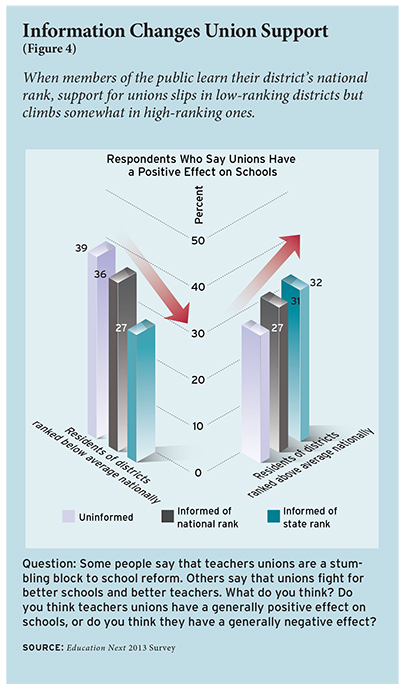 Teachers unions. To gauge the public’s assessment of teachers unions, we asked the following question: “Some people say that teachers unions are a stumbling block to school reform. Others say that unions fight for better schools and better teachers. What do you think? Do you think teachers unions have a generally positive effect on schools, or do you think they have a generally negative effect?” Only 32 percent of uninformed Americans respond favorably, while 43 percent claim that teachers unions have a generally negative effect. (Another 25 percent adopt a neutral stance.) It is interesting to note, though, that uninformed respondents from districts with below-average rankings express much more favorable views of teachers unions. No less than 39 percent have a positive view of unions, compared to just 27 percent in those districts with above-average rankings (see Figure 4).
Teachers unions. To gauge the public’s assessment of teachers unions, we asked the following question: “Some people say that teachers unions are a stumbling block to school reform. Others say that unions fight for better schools and better teachers. What do you think? Do you think teachers unions have a generally positive effect on schools, or do you think they have a generally negative effect?” Only 32 percent of uninformed Americans respond favorably, while 43 percent claim that teachers unions have a generally negative effect. (Another 25 percent adopt a neutral stance.) It is interesting to note, though, that uninformed respondents from districts with below-average rankings express much more favorable views of teachers unions. No less than 39 percent have a positive view of unions, compared to just 27 percent in those districts with above-average rankings (see Figure 4).
When informed about district rankings, Americans’ opinions about teachers unions shift in opposite directions. In below-average districts, positive evaluations of unions drop from 39 percent to 27 percent when state ranking information is supplied, while in above-average districts, positive assessments shift upward from 27 percent to 32 percent. A similar but less dramatic turnaround is observed when national ranking information is supplied.
Although informing people of the ranking of the local school district changes their views of teachers unions, the shift in opinion depends on whether the local district has a high or low ranking relative to other districts. Evaluations of unions climb by 5 percentage points if the respondent’s district is ranked high relative to other districts statewide, but falls by 12 percentage points if it is ranked low.
Teacher tenure. Information about local school rankings also depresses support for teacher job protections. Nearly half of the uninformed members of the public oppose teacher tenure, a third favor the policy, and the remainder do not take a position either way. When respondents are told how their local schools rank either in the state or country, support for teacher tenure falls even further, dropping by 6 or 8 percentage points, respectively. The difference between the informed and the uninformed in below-average districts is slightly larger: 6 percentage points when given state ranking and 11 percentage points when given national ranking.
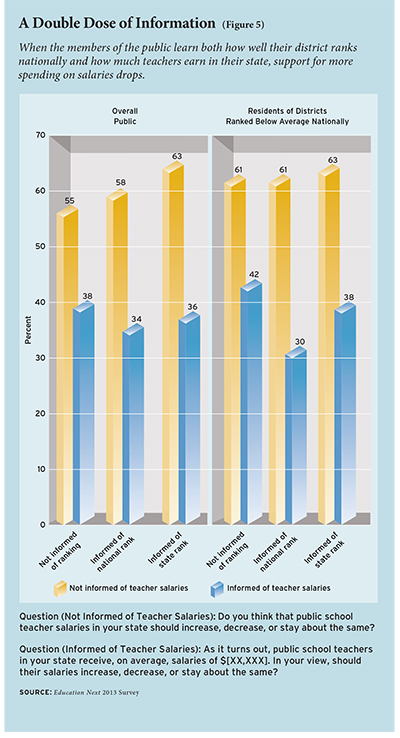 Teacher compensation. When it comes to teacher pay, the influence of information is more complex. Among uninformed respondents, 55 percent of Americans favor a salary increase. When respondents are told the state rankings of their local schools, that percentage climbs to 63 percent, and to 58 percent when told the national rankings (the latter change is not statistically significant). The public seems to be perfectly willing to pay teachers more in order to address the poorer-than-expected quality of local schools (see Figure 5).
Teacher compensation. When it comes to teacher pay, the influence of information is more complex. Among uninformed respondents, 55 percent of Americans favor a salary increase. When respondents are told the state rankings of their local schools, that percentage climbs to 63 percent, and to 58 percent when told the national rankings (the latter change is not statistically significant). The public seems to be perfectly willing to pay teachers more in order to address the poorer-than-expected quality of local schools (see Figure 5).
As it turns out, though, that conclusion is not altogether warranted, for when the public is informed about current teacher salary levels, its enthusiasm for salary increases wanes noticeably. Instead of 55 percent in favor, only 38 percent of those informed of current pay levels endorse salary increases. A further downward shift—to 30 percent support—occurs among respondents residing in school districts ranked below average nationally when both salary and ranking information are given. Among those living in above-average districts, however, support for raising teacher salaries remains essentially unchanged once they learn of their district’s standing nationally.
In other words, public views on teacher compensation are influenced by both information on current levels of spending and information about a local district’s ranking nationwide. If information on current salaries is not provided, support for salary increments goes up in those districts that rank above average when respondents learn this fact. However, information on current spending reduces public support for increased expenditure in all districts, and support for salary increments drops further in below-average districts when respondents are informed of both current salaries and of their district ranking.
Teacher policy overall. Taken as a whole, information about local school rankings has a less substantial impact on public thinking about teacher policy than it has on thinking about school choice policies. Whereas the impacts on school choice were large and consistent (other than for targeted vouchers), the impacts on teacher policy depend more on the district’s national ranking. Informed respondents living in below-average districts are more likely to lower their assessment of teacher quality, withdraw their support for teachers unions, become more opposed to teacher tenure, and grow more reluctant to back salary increments for teachers. Informed respondents living in above-average districts, however, actually back higher salaries for teachers (if uninformed of current levels) and give greater support to teachers unions.
Common Core and Public Opinion
If CCSS were to enhance public knowledge of the performance of local schools as compared to schools elsewhere in the state and nation, the impact on the school reform debate could be substantial, especially (but not exclusively) in those districts that are ranked below average nationally. Public assessments of local schools would shift in a more skeptical direction; support for universal voucher initiatives, charter schools, and the parent trigger would increase; limits to teacher tenure would gain greater public support; and both teachers unions and demands for increases in teacher salaries would confront greater public skepticism.
These conclusions come with caveats, however. When information is supplied as part of a survey, it is not subject to dispute by those who have an interest in obfuscating certain facts and emphasizing others. Further, our findings do not touch upon the substantive merits of a CCSS-based curriculum that is the focus of so much public discussion. And perhaps most consequentially, a long stride separates changes in public opinion and political action. Indeed, we find very little evidence that people would become more politically engaged if they actually knew the state and national rankings of their local school districts. It would take considerable leadership and political mobilization to capitalize on any changes in public opinion that CCSS might arouse.
Still, there is a certain irony in the fact that CCSS’s opponents favor many of the reforms that seem primed for winning greater public approval should the standards be fully implemented. Some have said that conservative opponents of CCSS are shooting themselves in the foot. Our evidence does not contradict that suggestion.
Michael B. Henderson is assistant professor of political science at the University of Mississippi. William G. Howell is professor in American Politics at the University of Chicago’s Harris School and co-director of the Program on Political Institutions. Paul E. Peterson is the director of the Program on Education Policy and Governance at Harvard University and senior fellow at the Hoover Institution.
This article appeared in the Spring 2014 issue of Education Next. Suggested citation format:
Henderson, M.B., Howell, W.G., and Peterson, P.E. (2014). Information Fuels Support for School Reform: Facts about local district performance alter public thinking. Education Next, 14(2), 26-35.


